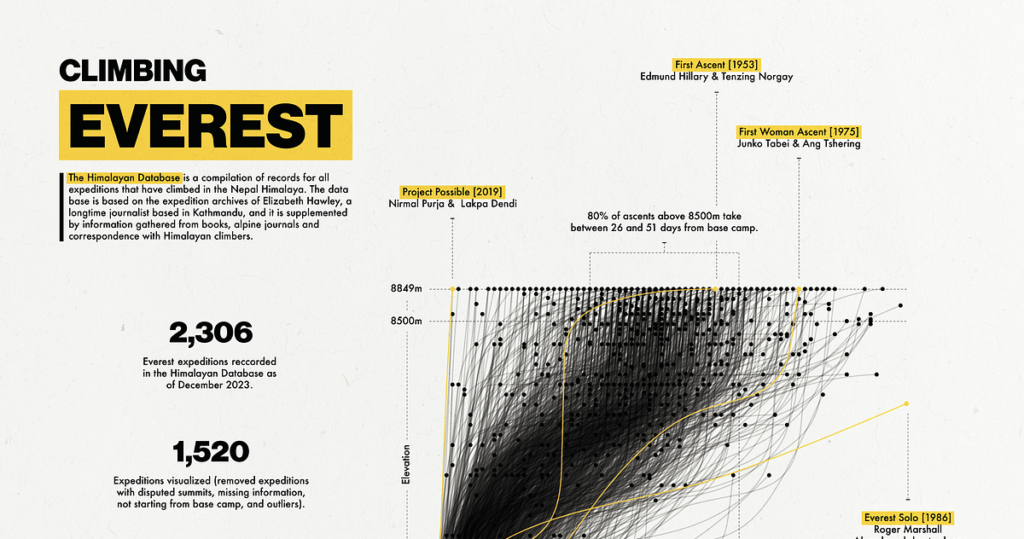
Date e elevazioni mancanti
La maggior parte delle voci nel file campsites la colonna ha questa forma:
'BC(08/12,5400m),C1(10/12,6000m),C2(14/12,6300m),C3(19/12,7500m),C4(10/01,7800m),xxx(10/01,7800m)'
Una stringa di nomi di campi, date (in formato GG/MM) e altitudini (in metri). Nell’esempio sopra, il primo campo è “BC” (campo base), la spedizione si è accampata lì il 12/08 e l’altitudine del campeggio era di 5400 m. Sfortunatamente, a volte mancano date e altezze. Ad esempio, spedizione EVER84101 (O EVER84101–1984 sotto il nuovo ID spedizione) ha le seguenti informazioni sul campeggio:
BC(08/03,5100m),C1,C2,C3.ABC,C4(12/04,7000m),C5(25/04,7680m),C6(15/05,8230m),C7(19/05,8540m),xxx(20/05,8600m)
Come puoi vedere, per questa spedizione mancano alcune date e altitudini del campeggio. Dovremmo essere in grado di stimare le altitudini dei campeggi osservando altre spedizioni, almeno per la maggior parte dei campeggi. Ad esempio, il campeggio C1 era probabilmente a circa 6000 m di altitudine (in base al primo record del campeggio che ho condiviso). Possiamo anche stimare una data per il campeggio BC (se mancasse) in base al valore in bcdate colonna, ma non possiamo stimare le date per i campeggi C1, C3 e C3. Ciò significa che non possiamo utilizzare questi campeggi come punti di passaggio per la spedizione. Ho deciso di eliminare i waypoint in cui non potevo recuperare la data e l’altitudine dal profilo altimetrico di una spedizione.
Informazioni mancanti del tutto
In altri casi, il campo del campeggio contiene semplicemente del testo che dice cose come “Vedi le descrizioni delle note del percorso per le singole squadre” o “vedi i dettagli del percorso”. In teoria è possibile recuperare alcune informazioni dal testo dei dettagli del percorso che assomiglia a questo:
South Side Camp Details:
BC at closest possible site to Icefall
C1 at top of Icefall
C2 at bottom of Lhotse Face in Cwm (normal site)
C3 on Lhotse Face right of Geneva Spur
C4 at South Col
C5 on SE Ridge (halfway South Col-South Summit).BC(28/03,5350m),C1(04/04,6000m),ABC(11/04,6500m),C3(19/04,7300m),
C4(28/04,7986m),C5(04/05,8300m),Smt(05,10/05)
North Side Camp Details:
BC(06/03,5154m),C1(11/03,5500m),C2(12/03,6000m),ABC C3(17/03,6500m),
C4(01/04,7028m),C5(08/04,7790m),C6(02/05,8200m),C7(04/05,8680m),Smt(05/05)
South team had to hurry up to catch up with N side climbers because were 10 days late at BC due to transport problems to BC (after 29 March in almost daily walkie-talkie radio contact with north side). No mountaineering problems but communications problems among 3 nationalities who had "quite different" ideas especially "Chinese who had quite a bureaucratic inflexible attitude." Chinese were CMA staffers or TMA staff members, not army who had to obey orders from North BC or later when contact established by radio with Beijing, orders from Beijing of what they must do - where as most Japanese members paid some fees to join. Nepalese on salary from NMA but were quite familiar to Japanese. Tibetans could not speak frankly to others because "observers" were in BC who were Han Chinese and Han Chinese at BC could not differ with Beijing.
South side climbing not much snow, so had packed ice. Icefall very dry and stable - on summit climb 5 May, deep snow on ridge. 5 May summit group planned to be 2 traversing parties: Top Bahadur Khatri in 2nd group but miscalculated oxygen supply with not enough on South Col: 24 bottles were there Ok but 17 or 18 empty on 4 May when these 6 and 6 support members on Col or above, hoping all to go to top. 2 Chinese were to go so went, Ang Phurba followed them to C5 to 8300m on 4 May - not enough oxygen at 8300m for Kitamura to go with them, so he stayed at C4 and tried to go to top on 5th from C4 early morning in very strong wind. Khatri and Isona and supporting members including Sungdare did not try to go up because oxygen at Col only enough for one summiter from there. Kitamura reached South Summit at 3:00 pm; was told it too late for him to continue, leadership felt, and told Yamada to bring him down.
7 May Beijing said climb finished but young Japanese and some Nepalese climbers did not agree. 6 Nepalese went to South Col: Sungdare, Padam Bahadur Tamang, Ang Karma, Ang Rita (Thami), Narayan Shrestha and Hira Bahadur Rana - why all 6 did not reach summit Isono doesn't know. Nepalese defied end of climb decision and it was their country, but Japanese were not permitted to continue, much to their unhappiness.
South Chinese climbing leader stayed in North Col camp with Shigehiro at end of climbing period.
North side 3 stages of climb:
1) make camps and carry loads to N Col,
2) do same to C6 with loads but not occupy higher camps - then all down
to BC for rest,
3) complete climb
In 1st stages down to BC when bad weather came after C3 established. In 2nd stage C6 reached but not slept in for 1st time on 9th April. In 3rd stage C6 occupied and rest of climb completed. Did not at any time have to wait for south side climbers to make progress because south side route easier to climb and number of camps less and fact summit date fixed for 5 May. team led by Yamada who knew south route. 6 Yamada selected before leaving Japan so could descend without south side climbers to guide them down. Oxygen used in C5 sleeping, same members climbing above C5, all members sleeping in C6 and C8 and climbing above C7. From summit Yamada left about 10:30 am with Ang Lhakpa and Cerin Douji. Linert Yamada party at top and left 11:00 am. Lhakpa Sona and Yamoumoto left 12:30 pm. Camera crew reached top just few minutes before south side trio arrived and left at 1:00 pm. 2nd traverse team in C5 ready to go to top (had ferried oxygen and food and fuel to C6 on 6 May) when decision taken late night 6 May by Chinese leader (final decision taken 3:00 am 7 May Chinese time) so 2nd team to N Col 7 May. In 2nd team was Mitani who would have been his 4th ascent.
(ADDITIONAL TEXT WAS REMOVED FOR THIS EXAMPLE)
Puoi vedere le informazioni sul campeggio che vogliamo siano disponibili all’inizio del documento (in realtà ci sono due squadre):
noth_side = BC(28/03,5350m),C1(04/04,6000m),ABC(11/04,6500m),C3(19/04,7300m), C4(28/04,7986m),C5(04/05,8300m),Smt(05,10/05)
south_side = BC(06/03,5154m),C1(11/03,5500m),C2(12/03,6000m),ABC C3(17/03,6500m),C4(01/04,7028m),C5(08/04,7790m),C6(02/05,8200m),C7(04/05,8680m),Smt(05/05)
Ho deciso di non tentare di recuperare le informazioni sul campeggio dai dettagli del percorso. Il motivo principale era che il testo non era disponibile nei dati delle spedizioni che avevo estratto e avrei dovuto:
- prendi di nuovo in prestito il laptop del mio amico per vedere se i dati sui dettagli del percorso erano disponibili,
- oppure scrivi un web scraper con Selenium per estrarre i dettagli del percorso da The Database himalayano online pagina.
Quindi, dovrei automatizzare l’estrazione delle informazioni sul campeggio. Poiché stavo creando questa visualizzazione per divertimento, ho deciso di non seguire questa strada e ho invece rimosso questo tipo di record dalla visualizzazione.
Squadre multiple
Un altro problema con le descrizioni dei campeggi è che alcune spedizioni contengono informazioni per più squadre:
BC(05-06/08,5250m),ABC(15-16/08,5821m),C1(20/08,6248m); W-Ridge.C2(03,05/09,6700m),C3(08/09,6900m)xxx(10/09,7240m); N-Face-xxx(23/09,7315m) (see route notes)
In questi casi ho mantenuto solo il primo percorso.
Fonte: towardsdatascience.com


